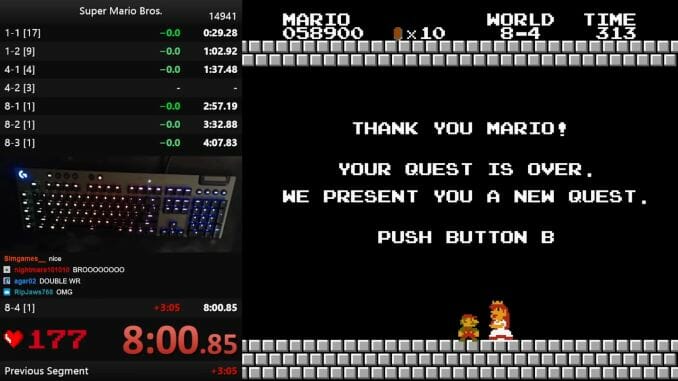In December 2021, Twitch user Niftski set a new world record: in 4 minutes, 54 seconds, and 881 milliseconds, he completed an any% run of the 1985 NES classic Super Mario Bros. This record comes more than 35 years after the game’s original release.
He’s far from the only competitor perfecting NES runs. Though not dedicated to any one console, the subreddit r/speedrun boasts more than 200,000 members and countless videos, many of which are attempts at, or world records of, NES runs. Speedrun.com, a website that aggregates record data, reports active players in dozens of NES games, with the highest in Super Mario Bros., Super Mario Bros. 3, The Legend of Zelda, and Ninja Gaiden, respectively. The most recent of those games were released in 1988.
That’s more than 30 years of playtime, but even so, speedrunners show no sign of stopping. Niftski in particular noted in the video description of his any% world-record run: “I’ll likely go for 4:54.7xx sometime in the future!”—to further cut back his time.
This never-ending quest for a better run can eat days of a player’s time. In the video description of a different record-setting run, Niftski thanked his fans for “positivity and love through the 5 days of this grind!” In the grand scheme of things, five days might not be all that long, particularly for streamers making some or all of their money by gaming. Even so, that’s a lot of resets on a game that came out when Reagan was president.
It may come as no surprise that the most active NES games, in early 2022, are what many consider the classics. The three most popular series on Speedrun.com all started long-term franchises, all of which are still active and had 2021 releases (Mario Party Superstars in the fall, preceded by Ninja Gaiden: Master Collection and The Legend of Zelda: Skyward Sword in mid-2021).
What is surprising, though, is how interest in retro games never seems to wane, even with the release of new titles and systems. What is it, exactly, that brings players back to NES titles, over and over and over again?
The easy answer, of course, is nostalgia. These are fan favorites, and some speedrunners grew up playing them. Game mechanics may also be important, though, and not in a nostalgic way. One thread on r/speedrun argued that precise controls are part of the draw for Nintendo speedruns. Newer games tend to have more complicated controls and longer cutscenes. Combine that with the fact that modern games also receive patches that remove exploitable glitches, and players are looking, generally speaking, at longer run times for newer titles.
All that said, the draw of NES games may be more complicated, and academic research on nostalgia paints a more complex picture. In psychology, a 2012 study noted the physiological benefits of nostalgia. They reported that, “Nostalgia—an emotion with a strong connotation of warmth—is triggered by coldness.” Once triggered, feeling nostalgic increased participants’ physical warmth, thereby offering them bodily comfort, which suggests that “nostalgia […] maintains psychological equanimity.” Viewed through this lens, players might return to an oft-played favorite not from nostalgia itself but in search of a certain calm or composure, without even realizing it.
Other studies have found similar results. Researchers in the fields of management and psychology teamed up to look at the impacts of nostalgia during the pandemic. Their study, published in 2021, found that “Nostalgia is a psychological resource that can be harnessed to raise happiness and help combat loneliness,” a finding consistent across three countries and 3,500 participants. This benefit is another possible explanation for why players might gravitate towards older games, beyond nostalgia for nostalgia’s sake.
It’s the same phenomenon noted by Mik Deitz here at Paste in a 2022 article on nostalgia and Minecraft. The game gave Deitz’s roommates a way to return to “childlike joy” amidst their complicated reality of graduating college and facing an uncertain future, an anecdotal example of nostalgia increasing players’ happiness.
Other disciplines may further our understanding of nostalgia’s role in gaming. A 2017 study in the field of media and communications focused on binge-watching TV shows—a repetitious, long-term activity that isn’t unlike the hours of practice that a world-record speedrun requires. The study suggested that binge sessions satisfied viewers’ “desires for enjoyment, efficiency, control, and fandom.”
As concepts, both enjoyment and fandom carry over into gaming, and efficiency, in the form of saving time, is speedrunning’s ultimate goal. That leaves control. In this study, participants cited their desire to either “freely choose” scenes or episodes to watch, or selectively skip around within an episode to create something like a highlight reel.
This doesn’t translate perfectly to speedrunning, where a player strategizes based on speed and not personal preference, but a speedrunner is exerting a type of control over the game and its design nonetheless: The creators of Super Mario Bros. didn’t intend for their game to end in five minutes. That’s something that speedrunners pulled off all on their own. It’s a different kind of control.
Of course, it’s important to remember that academic research can only offer lenses through which to consider nostalgia; it doesn’t provide blanket explanations. Practically speaking, every speedrunner’s reasons for playing a game will be different, and for some, nostalgia may not play a role at all. That said, though, the pull of the past is powerful. It keeps us replaying old favorites, again and again.
Natalie Schriefer often writes about pop culture, sexuality, and identity. Say hi on Twitter @schriefern1.
